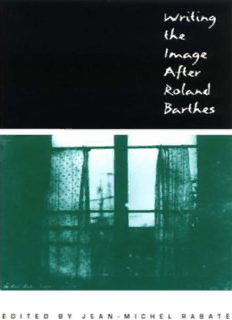
Writing the Image After Roland Barthes PDF
Preview Writing the Image After Roland Barthes
Writing the Image After Roland Barthes New Cultural Studies SeriesEditors Joan Dejean Carroll Smith-Rosenberg PeterStallybrass Gary A.Tomlinson A complete listof books in the series isavailablefrom the publisher. Writing the Image After Roland Barthes Edited by Jean-Michel Rabate PENN University of Pennsylvania Press Philadelphia Copyright ©1997University ofPennsylvania Press Allrights reserved Printed inthe United States ofAmerica on acid-free paper 10 9 8 7 6 5 4 3 2 1 Published by University ofPennsylvania Press Philadelphia, Pennsylvania 19104-6097 Library ofCongress Cataloging-in-Publication Data Writing the image after Roland Barthes / edited byJean-Michel Rabate. p. ern. - (Newcultural studies) "The chapters collected here were originally presented aspapers during the conference 'AfterRoland Barthes,' which took place at the University of Pennsylvania inApril 1994"-Introd. Includes bibliographical references and index. ISBN0-8122-3369-7. - ISBN0-8122-1596-6 (pbk.) 1.Photography-France-Philosophy. 2.Barthes, Roland-Criticism and interpretation. 3.Photographic criticism- France. I.Rabate, Jean-Michel, 1949- II. Series. TR183.W73 1997 770'.l-dc21 97-9579 CIP Contents List of Abbreviations vii Introduction 1 Jean-Michel Rabate I. Reflections on Photography 1.Barthes's Discretion 19 VictorBurgin 2. "What has occurred only once": Barthes's Winter Gardeny'boltanski's Archives of the Dead 32 Marjorie Perloff 3.The Filter of Culture and the Culture of Death: How Barthes and Boltanski Play the Mythologies of the Photograph 59 Nancy M. Shawcross 4. Barthes and Bazin: The Ontology of the Image 71 ColinMacCabe 5. Roland Barthes's Obtuse, Sharp Meaning and the Responsibilities of Commentary 77 DerekAttridge 6. Photographeme: Mythologizing in CameraLucida 90 Jolanta Wawrzycka 7.Narrative Liaisons: Roland Barthes and the Dangers of the Photo-Essay 99 CarolShloss 8. Circulating Images: Notes on the Photographic Exchange 109 Liliane Weissberg vi Contents 9. Roland Barthes, or The Woman Without a Shadow 132 Diana Knight 10.The Descent of Orpheus: On Reading Barthes and Proust 144 BerylSchlossman II.Seeing Language, Seeing Culture 11.The Imaginary Museum ofJules Michelet 163 Steven Ungar 12.Barthes with Marx 174 Philippe Roger 13.Beyond Metalanguage: Bathmology 187 PierreForce 14.Who Is the Real One? 196 Antoine Compagnon 15.The Art of Being Sparse, Porous, Scattered 201 Marjorie Welish 16.Genetic Criticism in the Wake of Barthes 217 Daniel Ferrer 17.Roland Barthes Abroad 228 Dalia Kandiyoti 18.Un-Scriptible 243 Arkady Plotnitsky Conclusion: AFalse Account of Talking with Frank O'Hara and Roland Barthes in Philadelphia 259 BobPerelman Bibliography 269 List of Contributors 277 Index 281 List of Abbreviations Throughout the present volume, references to works byRoland Barthes are provided parenthetically in the text of each selection. A bibliogra phy isprovided at the end of the volume. With the exception of the recently published three volumes of the CEuvrescompletes,abbreviations refer to available English translations of books by Barthes. Some contributors, however, have chosen to provide alternative translations. In such cases, and for those works for which no English translation exists, original sources are indicated in the notes of the given selection. BR A BarthesReader CE CriticalEssays CL CameraLucida CT Criticismand Truth EL ElementsofSemiology ES TheEmpireofSigns ET TheEiffrlTowerand OtherMythologies FS TheFashionSystem GV TheGrainoftheVoice IMT Image-Music-Text IN Incidents ID A Lover'sDiscourse MI Michelet MY Mythologies NCE New CriticalEssays OC1, OC2, OC3 CEuvrescompletes1,2, 3 OR OnRacine PT ThePleasureoftheText RB RolandBarthesbyRolandBarthes RF TheResponsibilityofForms viii Abbreviations RL TheRustle ofLanguage SC TheSemioticChallenge SFL Sadefbourierfl.oyola SZ S/Z lVDZ WritingDegreeZero Introduction Jean-MichelRabate Roland Barthes died in 1980: seventeen years should provide enough time to assess his lingering and pervasive influence on critical theory and move beyond the mere anecdote to witness how his figure has taken on the more momentous contours provided byfate. Barthes's "fate" can appear to have been determined in part by the fact that his last pub lished work was a treatise devoted to photography. The photographic image achieves exactly the effect I have described when mentioning "fate": it freezes a development, eternalizes 'what is an essentially mo bile object under a figure. Although one ought to be wary of the retro spective illusion that automatically metamorphoses a last book into a testament, this last word forced on him by death is not attributable to mere contingency. Barthes always wished to understand History-a term he systematically capitalized ---a.:saseries of snapshots, of immobile yet unstable exposures. From his earlier investigations into the works of the French historian Michelet, who endowed universal history with the mythological elements needed to transform his nineteenth-century bourgeois ideology into an epic, to his later encounter with an Eastern otherness so fascinated by the click of a camera, Barthes's trajectory ex hibits a constant and deep concern for the image. Initially, Barthes's position in the face of images seems to be a very suspicious or critical one: he stated his reluctance or hostility to "ana logical" forms of thought and art many times, always preferring the ethical cleanliness ofdiscursive - therefore, discrete, digital, articulated, and codified-formations. Language can demystify because it never ad heres to reality; its arbitrary nature introduces a differential space in which one can really think. The almost Sartrian terms I have just used still account for Barthes's convergence with Lacan's early condemnation of the "Imaginary" realm as that of the ego's subjective illusions. For both Sartre and Lacan, the stickiness of the subject's identification pro-
